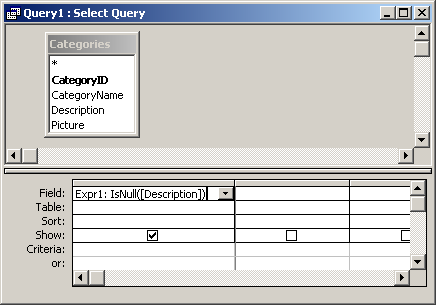
MS Access: IsNull Function
This MSAccess tutorial explains how to use the Access IsNull function with syntax and examples.
Description
The Microsoft Access IsNull function returns TRUE if the expression is a null value. Otherwise, it returns FALSE.
Syntax
The syntax for the IsNull function in MS Access is:
IsNull ( expression )
Parameters or Arguments
- expression
- A variant that contains a string or numeric value.
Returns
The IsNull function returns TRUE if the expression is a null value.
The IsNull function returns FALSE if the expression is not a null value.
Applies To
The IsNull function can be used in the following versions of Microsoft Access:
- Access 2019, Access 2016, Access 2013, Access 2010, Access 2007, Access 2003, Access XP, Access 2000
Example
Let's look at how to use the IsNull function in MS Access:
IsNull (null)
Result: TRUE
IsNull ("Tech on the Net")
Result: FALSE
Example in VBA Code
The IsNull function can be used in VBA code in Microsoft Access.
For example:
Dim LValue As Boolean
LValue = IsNull("Tech on the Net")
In this example, the variable called LValue would contain FALSE as a value.
Example in SQL/Queries
You can also use the IsNull function in a query in Microsoft Access.
For example:

In this query, we have used the IsNull function as follows:
Expr1: IsNull([Description])
This query will evaluate whether the Description field contains a null value and display the results in a column called Expr1. You can replace Expr1 with a column name that is more meaningful.
For example:
NullDescription: IsNull([Description])
The results would now be displayed in a column called NullDescription.
Advertisements



